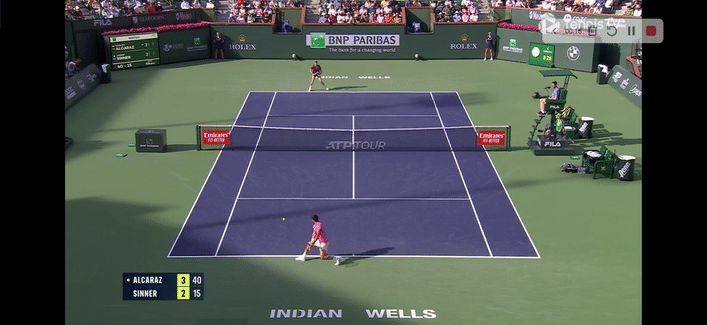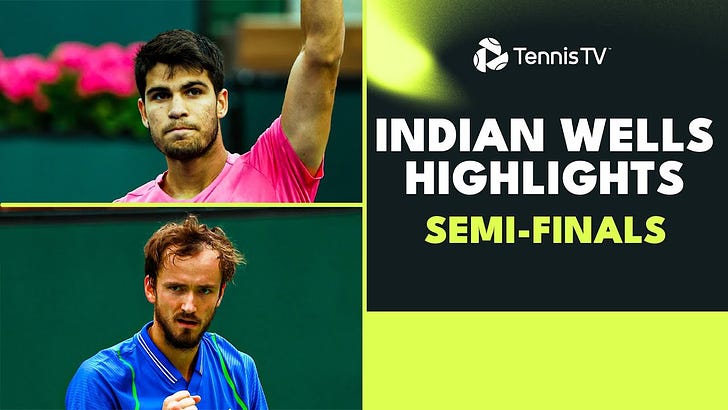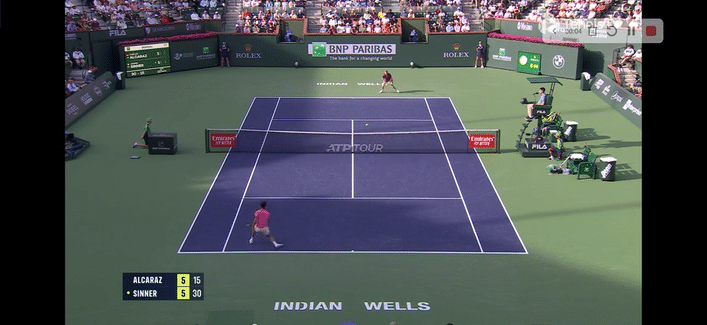Carlos Alcaraz defeated Jannik Sinner 7/6 6/3 to book his place in Sunday’s final of the Indian Wells Masters 1000. He takes on Daniil Medvedev, currently on a 19-match win streak. Medvedev is looking to win four tournaments on the trot, and Alcaraz can leapfrog Djokovic and return to number 1 in the ATP rankings with a win.
Before the match I tweeted a thread on tactics etc.

Dialed up to 11 was an understatement.
After their Wimbledon encounter last year, I wrote a piece on Alcaraz and Sinner indulging in some technical speculation as to how they might improve. You can read the piece for swing details, but I also felt they needed to reign in the aggression. An excerpt:
“The match between Sinner and Alcaraz, and the subsequent quarterfinal between Sinner and Djokovic were impressive outings for the two youngsters. In both matches they displayed a high level of tennis. Explosive? Yes. Talented? Yes. But, technically rock-solid like Djokovic, Nadal, and Federer at the peak of their powers? No. At least not yet. Can they get there? Yes. The brilliance may at times equal their predecessors, but what separated the Big-3 from the pack was the same high level coupled with a reduction in errors. Grand Slam tennis is a marathon. Every player will have good and bad streaks of play. The differences between the top brass and the field are imperceptible from watching highlights; all players look like winners during a patch of great play featuring a slew of confidently struck winners, but most points are decided by a miss, not a winner. The greats simply miss less; an extra return comes back, or an extra cross-court ball is made, which results in an opponent error, often at some insignificant moment—perhaps 15-0—but over time these accumulated points result in the extra breaks and holds that help them win so consistently and makes them so hard to beat; they rarely beat themselves.”
Today’s match—while full of sensational rallies and shots—only reinforced this feeling further. A look at the rap sheet:
Neither really got into a groove out there today, and I think it is partly due to the fact that they both have such aggressive instincts and don’t play end range defence at an ATG level (Alacaraz off the forehand perhaps does, but I’m not convinced of the backhand wing, yet).
Sinner sees every ball as a chance to hit a winner. Alcaraz sees every ball as a chance to get forward. Alcaraz often makes decisions to come in off shots while well behind the baseline and falling backward off the shot no less. Observe in the point below Sinner decides to return this second serve from a deeper position, but the kick pulls him so wide that he is a sitting duck for Alcaraz’s forehand. Alcaraz jets off for the net almost as soon as he hits the fall-away reverse forehand.

And here’s the real headache for players against Alcaraz. Compare the above point and notice that on the one below, Sinner decides to counter the kick and step in on the second-serve return, but now the recovery step necessitates that he is moving backward as he returns to the centre of the court. Alcaraz knows this.

It’s great to watch, and it’s exactly the shot in the arm tennis needs from a spectator standpoint. Variation. Risk-taking. Power.

104mph smokeshow from Carlitos below.
And then the very next point Sinner hits a blistering two-hander. No speed gun but I’ll call it around 95mph by the eye test.
Keep in mind these guys are pulling the trigger like this at 5-5. These are important points. I can’t remember a match-up that was this aggressive from two top players.
But ultimately, this brand of tennis falls short of a well-playing Djokovic, and it’s a shame the Serb couldn’t make it to the US to prove my point. 9 errors and 2 winners accounted for the first set tie-breaker. What’s more, Sinner was getting the upper hand when the rallies were extending, but he didn’t seem compelled to play patient at any point in the encounter. He missed and missed all the way to the finish line.
Against a player like Alcaraz, whose instinct is to create something at all times, the goal is constriction. This is how Nadal and Djokovic tamed Federer. It’s how Zverev tamed Alcaraz at last year’s French Open, and it’s how Sinner should play as well. He needs a defensive version of himself that can play deep middle like Djokovic and Medvedev and just force errors out of guys. Compare the Alcaraz and Sinner highlights with a match from two pretty good teenagers 16 years ago.1
Two conclusions I draw from this.
In general, Nadal and Djokovic placed a higher value on each point compared to Sinner and Alcaraz. Shot selection, margins, court positions, and rally length are all geared toward a very controlled version of baseline aggression.
The sport hasn’t changed at all and has essentially gone sideways (read: stalled) in a very interesting way.
And yet, Alcaraz is mowing down all sorts of records.

Is it possible his aggressive brand of forecourt genius can match the relentless discipline of Nadal and Djokovic over the long haul? I think the odds are against him in the modern game, but people will love watching him try, as they did Federer. An excerpt:
“…part of his [Federer’s] appeal was also the aggressive forecourt nature of his game in an era where, even for casual observers, implicit in that style was a degree of risk that was courageous and admirable. Wandering from the mode of topspin baseline attrition is usually a sign of fatigue or desperation, but Federer managed to splice power and spin with finesse in a way we hadn't seen before. Looking back, it was always going to fall short of the consistency of Nadal and Djokovic’s baseline games in terms of winning. But crowds care about more than just winning.”
Final thoughts
Sunday’s final is a great test for each man. Alcaraz seeks a first win over Medvedev and the Russian’s deep and absorbing baseline game will test the Spaniard’s patience. For Medvedev, a win over Alcaraz on this type of court would be very satisfying in the wake of his recent triumph over Djokovic.
The match is on Alcaraz’s racquet. He will dictate when the rally deviates from the baseline mode, either with an injection of pace, a sneak into the net, or the drop shot. Medvedev will be content to tame whatever chaotic genius comes his way with his typical no-fuss low and flat backhand. Importantly—and to his credit, he has done this well recently—Medvedev needs to be brave with his forehand when the opportunity presents itself; his confidence is high enough right now that I expect him to do that. It will be interesting to keep an eye on Medvedev’s positioning on the court—especially if Alcaraz reels off several drop shots early on. Still, on this court, I’m leaning toward Carlitos in 3 sets. Let’s hope both bring their best.
I know it’s just highlights but I think the point stands.







Just wanted to say I absolutely love your regular analysis’ and I get so much value from them, thanks for all the effort you put into them!
Great piece as always ! A little bit pessimistic maybe when it comes to facing Djokovic at slams, especially for Sinner who doesn’t have the same variation and forecourt feel as Alcaraz. Technical improvements ain’t easy and many next gen players tend to stale (for example Tsitsipas’s weaknesses are known for a while now, and I’m sure he knows them too but he still hasn’t been able to break them). So, even though both guys have plenty of time, I wonder how the two will fare in future slams, especially in comparison with Rune who seems to be better technically. I would be so sad if Carlos wasn’t able to beat Djokovic in a slam for example